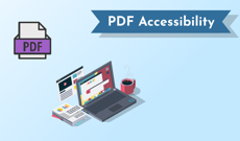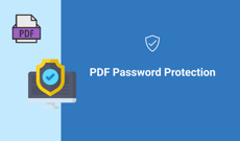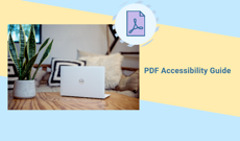Here at FlippingBook, we often talk about how important it is to provide a good reading experience with digital documents. Accessibility is an indispensable part of that experience, helping people with disabilities use your content and expanding your audience reach.
What’s more, accessibility is no longer optional, as it is now legally required in the USA, Canada, and many other countries worldwide. So, how do you comply and make your PDFs and flipbooks accessible?
In this article, we’ll discuss the accessibility criteria for digital content, explain how you can turn your PDFs into ADA-compliant flipbooks, and provide a PDF accessibility checklist for easy reference.
What Does ADA Compliance Mean For Digital Documents?
In simple terms, an ADA-compliant document can be used by people with disabilities. For example, if someone can’t see the content, they can read it. Or if they can’t use a mouse to scroll through, they can use keyboard shortcuts or voice control.
What laws and regulations govern accessibility?
In the USA, there are three main documents you can refer to for accessibility requirements.
1️⃣ The Americans with Disabilities Act (ADA) states that all places of public accommodation, including websites and content presented there, should be accessible to people with disabilities. The ADA applies to government-run institutions as well as private businesses.
2️⃣ Section 508 requires federal agencies to make sure that the information and communications technology (ICT) they provide is accessible to everybody. The ICT includes software, websites, PDF documents, and online training, among many other things.
3️⃣ Web Content Accessibility Guidelines (WCAG) offer specific requirements web content should meet to be considered accessible.
There are also the European Accessibility Act, the Accessible Canada Act, and others.
The list of criteria may vary from law to law, but the underlying idea remains the same: always to provide alternative ways to access the content.
What Makes PDFs and Flipbooks ADA-Compliant?
So, to make PDF content accessible, you will need to ensure that:
- video and audio content includes captions;
- meaningful images and non-text elements are paired with descriptive alt-texts;
- texts can be read with the help of assistive technology such as screen readers or voice access tools;
- texts are resizable, and the color contrast ratio is sharp enough to be easily distinguished;
- content navigation should be clear and helpful: documents should have a table of contents or bookmarks that allow users to move between the different sections of the document effortlessly.
Though easy to grasp, the concept is quite difficult to implement, and it becomes progressively harder with the complexity of the content you are working on.
For instance, a short text-only PDF can be made ADA-compliant just by ensuring the text is selectable, adding a table of contents and a meaningful title, and checking tags in Adobe Acrobat.
On the other hand, making a media-rich document such as a flipbook accessible can be a real challenge, as it contains so many different types of content, special elements, scripts, and so on.
The bad news is that the flipbook format has several technical limitations that prevent it from being ADA-compliant out of the box.
The good news is that you can still make your flipbook compliant with WCAG and ADA. But it requires a team effort of the flipbook provider and you as the user of the flipbook software to achieve the best results. In other words, we need to work together to make flipbooks as accessible as possible.
How to Check If Your PDF Is ADA-Сompliant
Taking all the information on ADA-compliant PDFs into consideration, we recommend you check if your PDF document is accessible before converting it into a flipbook.
Here are several options you can use:
- Use Adobe’s guide to check if your PDF is accessible.
- Run your PDF through a free PDF checker, such as PAC.
- Check your PDF yourself by running it through an ADA compliance checklist. You'll find one in the next section.👇
What FlippingBook Does to Make Flipbooks WCAG- and ADA-Compliant
Before we dive into the specifics of how FlippingBook complies with the ADA and WCAG, we need to discuss accessible PDFs.
PDFs are at the core of FlippingBook documents, so making them accessible is essential for succeeding. Unfortunately, we have no control over the content our users create, so you will need to do so on your own before you can start working on your flipbook.
To help you navigate through the process of creating an accessible PDF document or fixing your existing PDF, we’ve prepared an extensive step-by-step guide. Feel free to refer to it for more details.
Here’s a PDF accessibility checklist to help you identify the issues and fix them, if necessary:
- Make sure the text content is selectable.
- Create a clear content structure.
- Add a meaningful title and specify the language.
- Add bookmarks.
- Add alternate text to images.
- Caption the videos and other non-text content.
- Tag all elements correctly.
- Use high-contrast colors.
- Make links and forms descriptive.
- Make sure tables have a correct structure.
Once you have created an accessible PDF, you are halfway there.
Now let’s talk about what FlippingBook does to improve the accessibility of your flipbooks:
✅ An accessible PDF is available for download
For people relying on assistive technology to access your content, the best way is to ensure they can download a fully accessible PDF.
Both FlippingBook Online and FlippingBook Publisher offer an Accessibility feature that lets you add a separate accessible PDF to your flipbook. When you enable the feature, a special icon to download the accessible PDF will appear in the top right corner of your flipbook. The placement makes it easy for screen readers to find this option, and viewers can get the PDF instantly.
✅ The flipbook interface is adapted for assistive technologies
It means the interface has a clear structure and all the elements, such as buttons and menu items, have text captions. So if a user with a visual impairment uses a screen reader to access the publication, they will have no problems understanding the document’s layout.
Also, the language of the publication interface is preset and recognized by screen readers, which helps them render it more accurately.
✅ The flipbook offers alternative navigation options
Navigation can pose a challenge for people with different kinds of disabilities, visual impairment being just a special case. That’s why it is important to provide as many means of navigation as possible.
All the buttons and elements in the publication can be controlled with a keyboard as well as a mouse. For example, you can flip the pages by dragging them with a mouse, clicking the arrow button, or pressing an arrow key on the keyboard.
A user can navigate the flipbook with a table of contents, thumbnails, and a search option. They will be able to find the information they need quickly and efficiently, even in a very large document.
✅ The text in flipbooks can be zoomed in on
This is another important WCAG requirement that FlippingBook meets. Unless the text in your PDF is an image (which is a huge no-go all the same), users will have no problems zooming in and out on any device.
✅ The interface can be customized to meet the accessibility criteria
By default, the design of your publication meets the WCAG requirements for the color contrast ratio 3:1. As for the publication's content, please make sure the text has a contrast ratio of 4,5:1 when preparing the PDF.
Create your own accessbile flipbook
Let's go
What Else Can You Do to Improve the Accessibility of Your Flipbook?
The beauty of interactive documents such as flipbooks is that they make the content lively and rich. But in terms of accessibility, interactive elements may hinder access to the content for people with special needs if you don’t plan for them in advance.
Here are a couple of things you may consider if you want to use rich media in your flipbooks:
- If you use GIFs or pop-up images in the publication, please note that we cannot transfer them to the PDF you provide for download. We recommend substituting a dynamic element with a static image and a descriptive alt text in the PDF.
- Videos won’t be available in the PDF if you add them to the publication. Instead, you can insert a link to the video in the PDF document to make it accessible to your users. Please remember that all the videos should be captioned to comply with the ADA and WCAG standards.
- Background sound (available in FlippingBook Publisher) is okay when used to add a nice touch to the overall reading experience. But if it provides any exclusive information that is not paralleled by text, people with hearing impairment won’t be able to access it, and it may be considered discrimination.
ADA-Compliant Digital Documents FAQ
1. What does ADA compliance mean for digital documents?
ADA compliance means that digital content should be accessible to people with disabilities. For PDFs and flipbooks, this includes adding alt text for images, captions for multimedia, proper reading order, keyboard navigation, and color contrast that meets accessibility standards.
2. What is the difference between ADA, WCAG, and Section 508?
ADA is an American civil rights law that requires accessibility for people with disabilities, while Section 508 applies specifically to U.S. federal agencies. WCAG is a global standard that provides technical criteria for accessible digital content. Together, they help content creators ensure that websites and documents are accessible.
3. How can I check if my PDF is accessible before converting it?
You can test a PDF’s accessibility using tools like Adobe Acrobat Pro’s Accessibility Checker or free software such as PAC (PDF Accessibility Checker). Running these checks before converting ensures your flipbook will also meet accessibility requirements.
4. Which flipbook features are important for accessibility?
An accessible flipbook should support screen readers, keyboard navigation. It should also offer an accessible PDF download, clear labels for buttons and links, and color schemes that meet contrast standards. These features make sure all readers, including those using assistive technology, can fully interact with your content.
5. What laws regulate accessibility outside the USA?
In the EU, there is the European Accessibility Act. The UK enforces the Equality Act and Public Sector Accessibility Regulations. Canada has the Accessible Canada Act. Australia and other regions follow WCAG guidelines, making accessibility a global requirement.
6. What are common mistakes that make PDFs inaccessible?
Typical mistakes include saving PDFs as images without selectable text, omitting alt text for graphics, using poor color contrast, and leaving out captions for audio or video. Missing bookmarks, headings, or a clear document structure also make navigation difficult. These issues prevent people with disabilities from fully accessing your content.
Takeaways
With multiple rules and regulations enforcing accessibility in the global digital space, making your flipbooks inaccessible isn’t an option anymore. Moreover, ensuring everyone can use the content opens up opportunities for reaching a wider audience.
To make your flipbook accessible, first, you need to make your PDF accessible. It’s easier than you think, and you will check off most of the requirements by following good design principles. Make sure your text is well-structured and easy to navigate, don’t go overboard with colors, give links and graphics clear alt-text descriptions—and you are already on the right track.
And thanks to FlippingBook's accessibility features, you won’t have to choose between accessibility and interactivity when converting your PDF into a digital flipbook. Those who need an accessible version of your document will easily find it, and everyone will have the best experience with your digital flipbooks.





